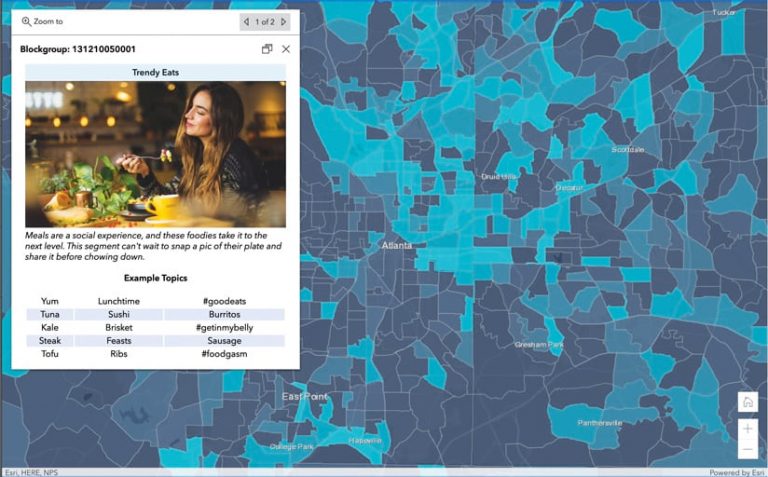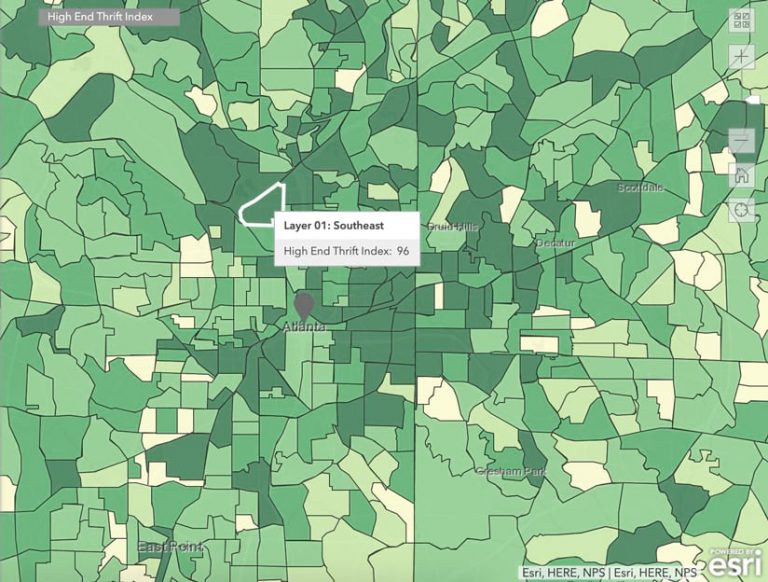With more than 328 million individuals in the United States, it can be very difficult for retailers to predict people’s preferences and purchasing choices. In recent years, GIS professionals have relied on demographics as the best proxy for making true behavioral predictions. But there’s a problem: people who appear to be demographically identical may have different interests and preferences. While demographics are helpful, they don’t tell the whole story. The missing piece is how humans actually behave at the individual level.
Every day, people across the country discuss their thoughts, opinions, preferences, and interests on social media. Esri startup partner Spatial.ai, a location intelligence and geosocial data provider, takes that data and studies it to better understand how humans experience the world and live their lives.

To uncover genuine behavioral trends, Spatial.ai uses geosocial data based on 72 behavioral segments that focus on people’s interests, lifestyles, relationships, entertainment preferences, and culture. These segments—which include Smart Chic, Yoga Advocates, and Foodies—are organized at the block group level, a census measurement of about 40 city blocks, and are intended to help users visualize a community’s interests and moods.
“Rather than boxing consumers into small subgroups, geosocial data creates connections between actions and activities, so it reflects that consumers are more than their demographic or psychographic labels,” noted Helen Thompson, group lead for content and applied analytics at Esri.
Spatial.ai develops its geosocial observations by sourcing data from residents of a given area who publicly post comments on social media. Privacy is important, so the startup only accesses data from users who have deliberately set their geolocated posts to be public, and no individual user data is collected.
Recently, TSCG Analytics, a division of TSCG (formerly The Shopping Center Group), was tasked with helping a high-end thrift retailer choose a new location in Atlanta, Georgia. The real estate advisory firm is on the cutting edge of leveraging key behavioral datasets to address the most pressing problems facing the retail real estate industry today. It helps clients with site selection, market optimization, trade areas and franchise territory definition, general mapping services, data access, and the development of online dashboards.
To enhance its already advanced geospatial techniques, TSCG partnered with Spatial.ai for this project to take advantage of the startup’s continually evolving data and resources. Being able to examine various aspects of a given community, such as people’s sentiments, personalities, and behaviors, enabled TSCG to create a brand profile for the thrift retailer that goes deeper than a simple demographic report. This allowed the client to form a clear understanding of the customer base surrounding its prospective store site.
Over the last three years, the market for secondhand stores has grown 21 times faster than the retail apparel market, and it’s expected to be a $51 billion industry by 2023, according to data from GlobalData, a retail analytics firm. So there was a lot at stake for the thrift retailer in choosing the right spot for its first shop in Atlanta.
The client wanted TSCG to help it understand which submarkets should be strategically considered based on how well potential customers’ characteristics aligned with the retailer’s current top-performing stores. There wasn’t much data to go on, though. The client didn’t generally collect any customer information, and there was limited existing access to resources and data that would help.

TSCG used a combination of mobile location sources, Esri Tapestry Segmentation data, and Spatial.ai’s detailed geosocial data to analyze potential locations for its client’s new store. TSCG collected the mobile location data through opt-in mobile apps, which allowed the firm to get a general understanding of people’s shopping patterns in certain areas of the city. It used the Tapestry Segmentation data—which classifies groups of people based on their values, interests, and lifestyles—to identify the overall psychographic segments of the block groups where local shoppers reside. And the firm used Spatial.ai’s geosocial data to refine its understanding of the behavioral groups that strongly represent the brand profiles of the client’s existing and potential resale store locations.
Two psychographic segments were targeted using Esri’s Tapestry data: Trendsetters, a segment of young, diverse, and mobile residents, and Metro Renters, who are typically young and educated singles. This allowed analysts to see that the brand’s customers were largely single urban dwellers who stay up-to-date with the latest technology, who often rent rather than own their homes, and to whom image is important.
Using Spatial.ai’s social activity analysis data, TSCG then created a more detailed brand profile for its client by identifying five top geosocial elements within a 10-minute walk of the company’s top-performing stores in other locations. These segments were Film Lovers, LGBTQ Culture, Artistic Appreciation, Mindfulness & Spirituality, and Yoga Advocates. A fuller picture of the brand’s audience began to emerge.
What set this high-end thrift shop’s customers apart was their love of indie films, support for the LGBTQ movement, appreciation of fine art, and connection with yoga and meditation culture. Esri’s Tapestry Segmentation data and Spatial.ai’s geosocial insights complemented each other by bringing additional context to each dataset. On its own, the Tapestry data represented interesting marketing observations, but TSCG was also able to quantify and map the areas that fit the demographic social profiles of the brand’s customers.
TSCG combined these variables into a high-end thrift index to capture each Atlanta neighborhood’s affinity for quality resale shopping. It then analyzed mobile location data to discover which block groups within that profile also housed Trendsetters and Metro Renters. Retail sites close to those block groups were given priority.
Taking Esri’s Tapestry Segmentation data together with Spatial.ai’s datasets allowed TSCG Analytics to not only identify specific submarkets in Atlanta but also rank retail sites within those markets that met the brand’s demographic profile according to which areas would likely receive heavy visitation from matching customer types. In the past, this would have required TSCG to perform a large number of demographic analyses and spend hundreds of hours doing qualitative interviews and in-store intercepts. Spatial.ai was able to help TSCG capture all this information in less than a day. Even better, with this experience as a model, TSCG Analytics was able to lay the foundation for the thrift retailer to develop a powerful hyperlocal marketing strategy to use going forward.




